By Alexander Watson (Guest Contributor)
“Every day now brings turnips, turnips and still more turnips.” The hunger felt across Central Europe during the First World War is barely remembered today, but for millions of German and Austro-Hungarian civilians, as for the Hamburg girl who wrote those words in January 1917, it was the conflict’s defining experience. A desperate search for food dominated wartime life. Malnutrition and, in some places, starvation had killed around a million people in Central and Eastern Europe by the end of 1918.

People queue in front of a “goulash gun”. The deployment of these mobile field kitchens onto the streets of Germany was one method by which the government tried to rationalize the feeding of the population. Each contained around 1,400 portions of stew.
The food shortages were partly a consequence of mobilisation for “total war”. By 1915, the drafting of hundreds of thousands of farm workers and horses to the army, soil exhaustion and bureaucratic inefficiency had precipitated crises in production and distribution. Yet the shortages were also engineered deliberately by the ring of enemies surrounding Germany and Austria-Hungary. Britain used its naval supremacy and diplomatic clout ruthlessly to halt imports to Central Europe. The Royal Navy closed the entire North Sea to international trade. What could not be blocked was purchased: Norway’s herring catch, for example, was cornered by the British and then left to rot, solely to deny it to hungry Germans.
The Central Powers struggled to overcome dearth. Officials slowly tried to centralise food management and experimented with rationing and mass soup kitchens. More darkly, occupied territories’ food stocks were callously seized. Society mobilised to search for substitutes. At universities, historians scoured dusty manuscripts to discover what people had eaten in earlier famines. Chemists tried to extract oils from grape and poppy seeds. Private business also strove to fill gaps in the markets. In all, 11,000 so-called “Ersatz” (replacement) foods were produced. Most ranged from the unappealing, through disgusting to actually poisonous. For example, in the absence of flour, wartime sausages could legally be filled with 70 per cent water, becoming squidgy tubes of slime. Walnut shells, plum stones and even turnip heads went into wartime coffee, and dishonest traders mixed sawdust into bread and marketed ash as pepper substitute.

“Citizens’ Cooking Recipe”. A satirical German postcard from 1917 explaining how to make a meal solely from ration coupons unredeemed because the food was unavailable: “Take the meat ration card, coat it in the egg ration card and fry nicely brown with the butter card …”
The unappetising and inadequate diet had disastrous consequences for Germany and Austria-Hungary. Hunger eroded popular support for the conflict. It also delegitimised governments incapable of feeding their peoples. In both states, malnourished citizens rose up at the war’s end in revolution. Worse, the obsession with food security provoked by the trauma would contribute to even greater horrors a quarter of a century later. The Nazis’ genocidal ambitions to annex agricultural “living space” in the east would be motivated not just by vicious racial ideology but also – with the memory of the First World War still strong – by determination to make Germany, as Hitler himself put it, “the most blockade-proof place in the world.”
 Alexander Watson is Lecturer in History at Goldsmiths, University of London. His new book, Ring of Steel: Germany and Austria-Hungary in World War I, has just been published by Basic Books.
Alexander Watson is Lecturer in History at Goldsmiths, University of London. His new book, Ring of Steel: Germany and Austria-Hungary in World War I, has just been published by Basic Books.
